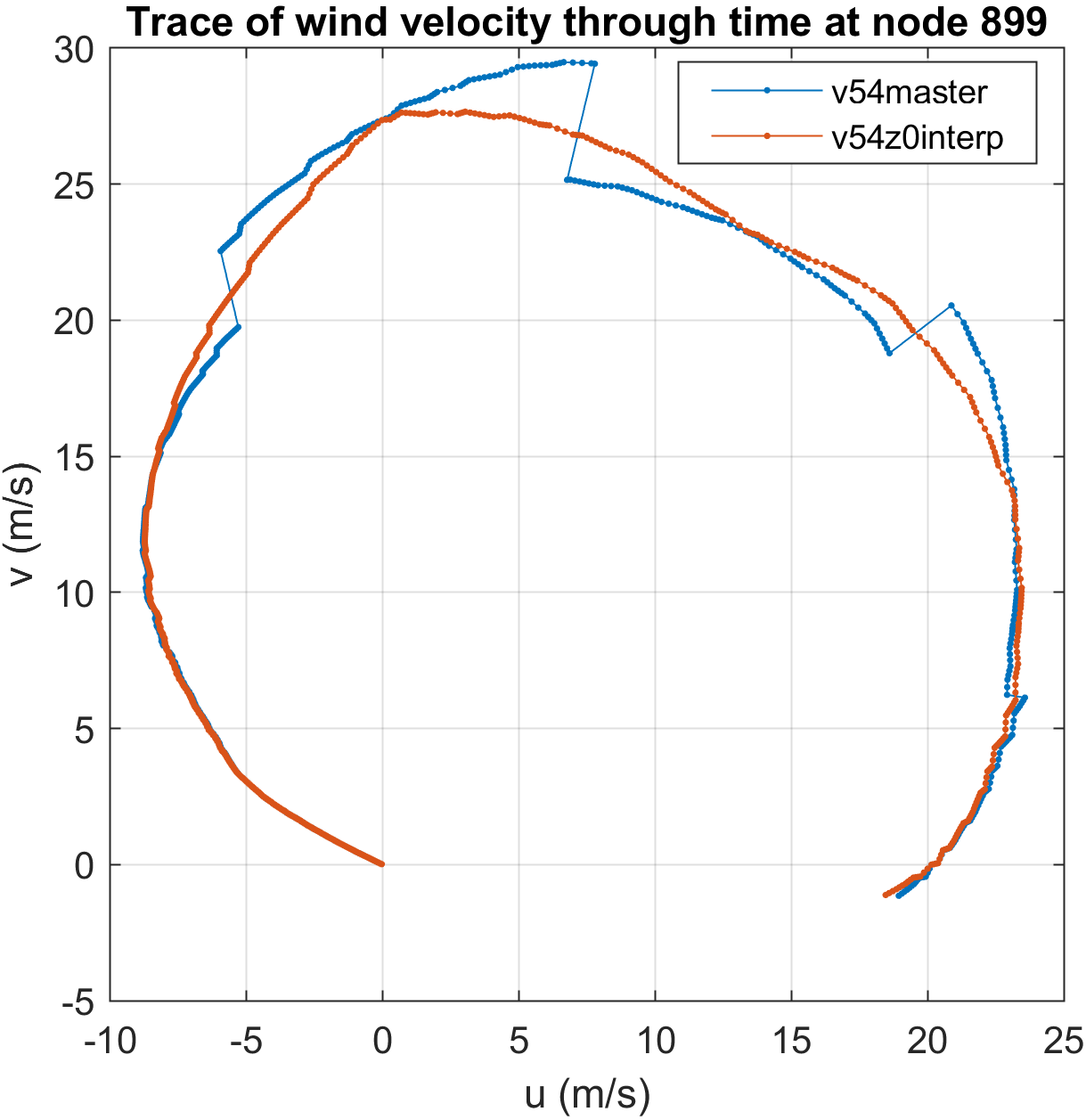Wind Stress
When wind blows over the water, it exerts a shear stress at the water surface that transfers horizontal momentum vertically downward across the air–sea interface, driving circulation. In ADCIRC, wind stress is an input forcing term, with several different formats provided. See the NWS Parameter for available formats. In most cases, the exact wind stress to be applied to the model is not provided, therefore ADCIRC must determine how to convert a given wind speed to the actual stress applied at the ocean surface. This page covers the various aspects of this process, as well as the options available to the user.
Definition of Winds
The characteristics of wind forcing are often broken down in three ways:
Whether the winds are considered to be over-water (termed “marine exposure”) or over-land
The elevation above the sea (or ground) surface of the winds
The time-averaging (if any) that has been applied
ADCIRC generally expects 10-meter, 10-minute winds at their actual exposure,
although the exact expectations vary depending on the input type. For instance,
when Holland-type wind inputs are provided (e.g. NWS=8 or NWS=20), the
wind speed is expected to be the 1-minute maximum sustained
wind at 10 meters
elevation. If marine-exposure winds are provided, then surface
roughness reductions may be needed [1]
[2] . If winds are provided with a different averaging time, then an
appropriate correction may be needed, though winds with averaging times of 10 to
60 minutes are generally considered to be quite similar; this is the so-called
mesoscale gap. For recommendations on wind time-scale conversions not handled
internally by ADCIRC, for tropical cyclones, see the WMO guidelines of Harper et
al. [3]
Roughness Reductions
Reductions in wind speed to convert to the appropriate exposure come from a logarithmic boundary layer formulation (see, e.g. [1] [2]) to determine a fraction \(f\) to reduce the winds,
for marine roughness length \(z_{0m}\) and reduced (“land”) roughness length \(z_{0l}\). Wind speed is then reduced as,
for x- and y- wind vector components \(u\) and \(v\). The marine roughness length is,
for Charnock parameter \(0.018\), drag coefficient \(c_d\) and acceleration due to gravity \(g\). The wind drag coefficient is addressed below in this section. As previously noted, the reduced (“land”) roughness length \(z_{0l}\) is specified by the user via the surface roughness nodal attribute. The fraction \(f\) is bounded on \([0,1]\), meaning the winds cannot be increased, nor change direction.
Older Behavior
Interpolating Roughness Lengths Before v55

Roughness Reduction Bug Before v54
Before version 54, there was a bug in this calculation. The mistake and its effects are addressed in this PDF document: ADD A LINK TO A PDF HERE.
Converting Wind Velocity to Wind Stress
In ADCIRC, four formulations are available to convert wind velocities to the wind stresses applied in the momentum equations. Although there are several ways to control this, users are generally encouraged to use the metControl namelist in the fort.15 file. The default drag formulation is the Garratt [4] linear formula. An alternative for use with tropical cyclones is the Powell formulation, [5] which varies drag by the sector of the tropical cyclone. When ice coverage is included in the model, a wind drag formulation that accounts for this effect should be used. By default, if ice coverage input data are supplied, ADCIRC uses a cubic function of ice coverage, termed the “IceCube” drag formulation. Lastly, the “swell” drag law option allows users to utilize SWAN’s drag formulation when employing the coupled model.
In all cases, the actual wind drag coefficients determined by ADCIRC can be
output to a fort.63-type file named
winddrag.173. Output settings (file format, output start/end
times, and output interval) match those of either the fort.63 or fort.73/74
files. Outputting of this file is enabled by setting
outputWindDrag=.TRUE. in the &metControl namelist of the fort.15 file’s
namelist section.
Garratt Drag Formulation
This is the default wind drag formulation in ADCIRC. From Garratt (1977) [4], the formula is,
By default, ADCIRC puts an upper bound on the drag coefficient of
\(c_d\le0.0035\). This upper bound WindDragLimit can be changed via the
metControl fort.15 namelist.
Powell Drag Formulation
CONTRIBUTOR NEEDED Note that the code for the Powell drag law has not been configured to reverse orientation in the southern hemisphere, and so will produce the wrong results. For details on Powell, see this post.
IceCube Drag Formulation
CONTRIBUTOR NEEDED
